- Depi nan Ginen bon Nèg ap ede Nèg!
- jafrikayiti@gmail.com
What is Canada Doing in Haiti?

JUSTICE FOR HAITIANS KILLED OR CRIPPLED BY THE UNITED NATIONS – SINCE 2004
April 22, 2017
Has Canada Reached Maturity at 150?
July 1, 2017What is Canada Doing in Haiti?
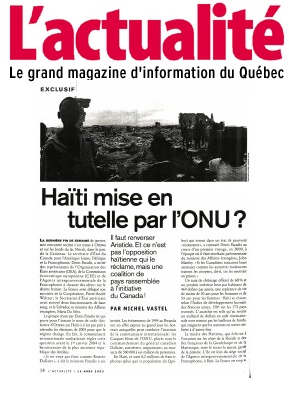
The “Ottawa Initiative on Haiti”: Humanist Peacekeeping or…?
On Sussex Drive in Ottawa, just a few steps away from the enormous US embassy, stands the Peacekeeping Monument. The structure titled “Reconciliation” was erected to honour the more than 125,000 Canadians who have served in United Nations peacekeeping forces since 1947. The current article documents one particular instance –the February 2004 intervention in Haiti – where the historical record conflicts with the “good peacekeeper” narrative communicated by the Canadian government, reiterated by the corporate media, and represented by “Reconciliation.”
Seeing themselves as a generous people, most Canadians also consider that their noble ideals are reflected in the foreign policy of their government. The importance of nurturing this positive image both at home and abroad is well ingrained in the national psyche and, every now and again, surveys are conducted to confirm its resilience.[1]
Walter Dorn, Associate Professor at the Royal Military College of Canada, writes that:
For Canadians, peacekeeping is about trying to protect people in mortal danger… about self-sacrifice as well as world service. These notions of courage and service resonate with the public, and politicians across the political spectrum have readily adopted the peacekeeping cause… Canadian support for its peacekeeping role has been so strong for so long that it has become a part of the national identity.[2]
Canada’s intervention in Haiti is represented and legitimized in such terms. On the very first line of the section of its website devoted to Haiti, the Canadian International Development Agency (CIDA) boasts how “Canada has committed to allocate $555 million over five years (2006-2011) to reconstruction and development efforts in Haiti.” Such “special consideration” is given to Haiti because “[t]he Government of Canada is committed to helping the people of Haiti improve their living conditions.”[3] Unequivocally endorsing the government’s line as reiterated by its Ambassador to Haiti, Claude Boucher, Maclean’s Magazine answers its own question in an April 2008 feature article: “it’s easy to forget that what Boucher says is true. Haiti is a less dangerous, more hopeful place than it has been for years, and this is the case, in part, because of the United Nations mission there and Canada’s involvement in it.”[4]
The Ottawa Initiative
In contrast to Maclean’s pronouncement, a growing number of international critics insist that what is happening in Haiti is instead an odious imperialist crime in which Canada is shamefully complicit.[5] These skeptics argue that in January, 2003 the Canadian government organized a meeting to plan the illegal and violent overthrow of the democratically-elected government of the small Caribbean nation for political, ideological and economic reasons.[6] The meeting, called the “Ottawa Initiative on Haiti,” was held at the government’s Meech Lake conference centre in Gatineau, Québec, on January 31 and February 1, 2003, one year before the February 29, 2004 coup d’état.
The extraordinary decisions taken at this gathering of non-Haitians were first leaked to the general public in Michel Vastel’s March 2003 article, published in French-language magazine l’Actualité. Under the prophetic title “Haiti put under U.N. Tutelage?,” Vastel described how, in the name of a new Responsibility to Protect (R2P) doctrine, parliamentarians of former colonial powers invited to Meech Lake by Minister Denis Paradis, decided that Haiti’s democratically-elected president, Jean-Bertrand Aristide, had to be overthrown, a Kosovo-like trusteeship of Haiti implemented before January 1, 2004 while the US- subservient Haitian Army, the Forces armées d’Haiti (FAdH), would be reinstated alongside a new police force. The UN trusteeship project itself first surfaced in 2002 as mere rumor (or trial balloon?) in the neighboring Dominican Republic’s press.
While Canadian soldiers stood guard over Toussaint Louverture International Airport in Port-au-Prince, the president of Haiti and his wife were put on an airplane by US officials before dawn on February 29, 2004. According to world-renowned African-American author and activist Randall Robinson, who interviewed several eye-witnesses, the aircraft was not a commercial plane. No members of the Aristide government and no media were at the airport as Mr. and Mrs. Aristide were effectively abducted and taken to the Central African Republic against their will, following a refueling stop in the Caribbean island of Antigua.
***
In its December 10, 2004 report titled “An Economic Governance Reform Operation,” the World Bank bluntly declared that (thanks to the coup), “The transition period and the Transitional Government provide a window of opportunity for implementing economic governance reforms with the involvement of civil society stakeholders that may be hard for a future government to undo.”[7] Within the same post-coup period, said transitional government adopted a budget plan baptised “interim cooperation framework” (ICF) which outlined extensive privatization measures, accompanied by massive layoffs of public sector employees. This was done without the benefit of any legal sanction from a Haitian parliament. De facto Prime Minister Gérard Latortue, who was hand-picked by the U.S. to implement the ICF, promptly began the distribution of $29 million dollars to remobilized soldiers and paramilitaries whom the Central Intelligence Agency (CIA) had recruited and trained for the coup over the previous years in neighboring Dominican Republic and whom Latortue dubbed “freedom fighters”. The announcement of special pay to Latortue’s “freedom fighters” was made within days of a December 6, 2004 announcement of new “aid to Haiti” by the Canadian government.[8]
As of September 2008, most of the objectives attributed to the Ottawa Initiative have come to fruition. Haiti’s democratically–elected government has been overthrown, the country has been put under UN tutelage, new armed forces have been formed, and former President Jean-Bertrand Aristide is still in exile. As for Canada’s promised “improvement to living conditions”, such improvements can easily be demonstrated for the over 9000 foreign troops (police and military) whose salaries have in many instances doubled during their tour with the UN force in Haiti (MINUSTAH). However, as far as the overwhelming majority of Haitians are concerned, there are no reasons to rejoice. In the past five years, they have been subjected to an unprecedented wave of kidnappings, rapes and murders, among other forms of urban violence. The Haitian state has been further weakened and destabilized. The trauma and social divisions of the Haitian people have been greatly exacerbated as a consequence of the coup. Understandably, many charge that the R2P doctrine has proven to be “a nightmarish and violent neo-imperialist experiment gone terribly mad” conducted on Haitians in blatant contravention of international law.[9]
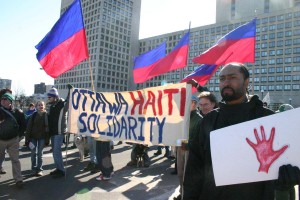 At the time of the first leak of the Ottawa Initiative meeting to the public, Canadians of Haitian origin warned Prime Minister Jean Chrétien not to engage in such “a foolish adventure in neocolonialism.”[10] But these warnings were to no avail. After several changes in government in Ottawa, there is no indication of any change in policy. On the contrary, Canadian officials are steadfastly implementing the same ill-fated policy while disingenuously diverting blame for failure onto its victims. Does it not speak volumes that in Haiti, as in foreign-occupied Iraq or Afghanistan, kidnappings and the “brain drain” are two phenomena that have markedly intensified with the arrival of the foreign troops?[11]
At the time of the first leak of the Ottawa Initiative meeting to the public, Canadians of Haitian origin warned Prime Minister Jean Chrétien not to engage in such “a foolish adventure in neocolonialism.”[10] But these warnings were to no avail. After several changes in government in Ottawa, there is no indication of any change in policy. On the contrary, Canadian officials are steadfastly implementing the same ill-fated policy while disingenuously diverting blame for failure onto its victims. Does it not speak volumes that in Haiti, as in foreign-occupied Iraq or Afghanistan, kidnappings and the “brain drain” are two phenomena that have markedly intensified with the arrival of the foreign troops?[11]
Four shaky pillars
The post-coup regime in UN-occupied Haiti rests on four unstable pillars: money, weapons, class solidarity and racism.
Money: Those who call the shots in Haiti today are those who control the bank accounts. Contrast, for example, the $600 million budget of the UN force with that of the Republic of Haiti. The latter grew from $300 million in 2004-05 to $850 million in 2005-06 to 1.8 billion in 2006-07 and finally to $2 billion in 2008-09, with the caveat that above 60% of the budget is dependent on foreign sources and their associated conditions. President Préval’s pleas for MINUSTAH tanks to be replaced by construction equipment remain as futile as they are incessant.[12] The “grants” allocated to Haiti at never-ending donors’ conferences are largely directed towards the donor’s own selected non-governmental organizations.
In response to last year’s food riots, Préval vowed in a speech delivered in Creole that he would no longer subsidize foreign rice imports but would instead stimulate the production and consumption of Haitian rice. This statement was retracted in a matter of hours, and Préval announced instead that he was in fact using the country’s meager resources to subsidize imported (American) rice to reduce the retail price by 16 percent.[13] The balance of power being what it is in these complex relationships, Haiti is expected to accept without a whimper the poisoned gifts “donated” by her generous benefactors in the name of “peace” or “humanitarian aid.” I recall how in 1997, when confronted with the poor quality of a foreign “expert’s” report submitted to the Minister, a junior Canadian NGO staff person, who was supposedly working in support of Haiti’s Ministry of Environment, arrogantly interjected that “beggars cannot be choosers.”
Weapons: MINUSTAH, comprised of some reputedly ruthless forces of repression including those of Brazil, China, Jordan and the U.S. has no rival on the ground in terms of sheer fire power. MINUSTAH’s marching orders are especially clear following the “suicide” of its former military leader, Brazilian General Bacellar, who was found dead on January 7, 2006, following a night of heated exchange with members of Haiti’s business elite who were openly critical of him for being too “soft” with “slum gangs”, “bandits” or “chimères.” MINUSTAH serves the role of place holder for the defunct Haitian army (FAdH), the traditional tool by which Haiti’s elites and their foreign allies have kept the “black masses” under control. “In the context of a country with an estimated 210,000 firearms (the vast majority of which remain securely in the hands of its ruling families and businesses)”, writes Peter Hallward, “it may be that a ‘chimère’ arsenal of around 250 handguns never posed a very worrying threat.”[14] The dramatic increase of weapons entering Haiti by way of Florida immediately after the 2004 coup suggests that the powers in place aren’t willing to take any chances.
Class solidarity: By caricaturing the base of support for the toppled Lavalas government as a violent underclass of “chimères” (monsters), mainstream media inside and outside of Haiti helped the coup forces to gather much sympathy. The attack on Lavalas was systematic, but the casualties of the coup went far beyond a single political party. Today, there remains not a single political party in Haiti which is independent of the foreign forces. Préval himself declares that he does not belong to a political party.[15] The Lespwa platform under which he was elected is already in shambles. Hallward provides an in-depth analysis of 20 years of efforts deployed by the US and its allies to destroy Haiti’s emerging popular democracy. The devastating impact of the assassinations in the 1990s of key figures of the progressive bourgeoisie linked to Lavalas, such as the Izmery brothers, attorney Guy Malary, agronomist and journalist Jean Dominique, are key to understand the class struggle still unfolding in Haiti. The web of connections between the Port-au-Prince-based ambassadors, NGO directors, food importers and sweatshop owners, all of whom live in the same neighborhoods, send their kids to the same schools and have developed an acute sense of (Apartheid-like) community is an important element that remains to be thoroughly researched, documented and analyzed. Meanwhile, mainstream media continues to propagate the stereotypes which sustain this mentality of a “besieged class” that must be protected from “savage others.”[16]
In order to meet the class-based “responsibility to protect” they have assumed in post-Aristide Haiti, Canada, the US, the UN and the Préval Government are steadfastly enforcing undemocratic and illegal practices such as the maintenance in African exile of former President Jean-Bertrand Aristide and the exclusion of his Fanmi Lavalas party from the Senatorial elections of April 19, 2009[17]. Clearly, rather than contribute to inter-Haitian reconciliation, social appeasement or political stability, such practices further exacerbate political tensions among a people that has heroically struggled for peace but have consistently been denied the benefit of genuine international brotherhood.
Racism: The lingering influence of white supremacist ideology in world affairs is seldom referred to in mainstream publications about Haiti. Yet, it is a key pillar of the Ottawa Initiative and the R2P doctrine on which it was predicated. Indeed, the racial features of the conflict brewing in Haiti are quite visible.
At the international level, the anti-coup and pro-Haitian sovereignty positions adopted by members of the US Congressional Black Caucus, the nations of the Caribbean and Africa, have consistently stood in sharp contrast to those in the US White House, Canada and Europe.
In Haiti, the black majority stands in opposition to a foreign-backed minority represented by the likes of white American sweatshop owner André Apaid, his brother-in-law and unsuccessful presidential candidate Charles Baker, American Rudolph Boulos, his brother Reginald Boulos, Hans Tippenhauer, (uncle and nephew of the same name), Jacques Bernard, etc.[18]
The similarities abound with the 1915 US occupation of Haiti which resulted in the imposition of a string of light-skinned, U.S.-subservient, dictators ruling Haiti: Sudre Dartiguenave, Louis Borno, Elie Lesco, Louis Eugene Roy and Stenio Vincent. As in 1915-1934, members of Haiti’s black majority resisting the humiliating occupation of their land today are deemed to be a horde of “bandits” who endanger “private property.” Back in the 20th century the private property being protected by Yankee troops was mostly American. Today, MINUSTAH’s ‘responsibility to protect’ also extends to important Canadian investments such as Gildan Active Wear’s sweatshops and Ste-Geneviève Resources’ gold exploration concessions.[19]
In a research paper titled Defining Canada’s role in Haiti, Canadian Armed Forces Major J.M. Saint-Yves writes that:
“While the solutions may sound colonial in nature it is clear that the endemic corruption of Haitian society will prevent the establishment of a sound economic solution to Haiti’s problems under Haitian control. Rather, foreign investment under foreign control is required to establish a new Haitian economy based on industries that will directly benefit the rural Haitian population”.[20]
As we will see in further detail, the “foreign control” Saint-Yves is calling for is already in place. But, it appears that the results of such racist and imperialist take-over have thus far proven to be the kind of ugly orphan that no one wants to officially claim as their own.
Documenting Canada’s Role
From the early hours of the coup, Haitian-American activist and attorney Marguerite Laurent has been a powerful and relentless voice denouncing the overthrow of the Aristide government and in documenting its consequences for thousands of people worldwide. “If justice, and not power, prevailed in international affairs,” writes Laurent, “the coup d’état corporatocracy in Haiti, that is, the governments (US/France/Canada), international banks and rich multinational corporations, and their Haitian minions who funded the overthrow of Haiti’s elected government, would be paying reparations to the people of Haiti who lost and continue to lose loved ones, property, and limbs.”[21]
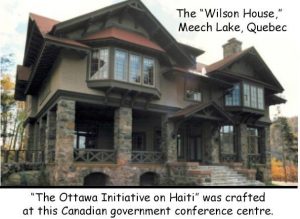 Ten days after the coup, Stockwell Day, then-foreign affairs critic for the Conservative opposition, declared in Parliament that “… we have an elected leader Aristide. We may not have wanted to vote for him… But the (Canadian) government makes a decision that there should be a regime change. It is a serious question that we need to address. That decision was based on what criteria?”[22]
Ten days after the coup, Stockwell Day, then-foreign affairs critic for the Conservative opposition, declared in Parliament that “… we have an elected leader Aristide. We may not have wanted to vote for him… But the (Canadian) government makes a decision that there should be a regime change. It is a serious question that we need to address. That decision was based on what criteria?”[22]
At first, the Liberal government attempted to cast doubt on whether the infamous coup-plotting meeting of January 31, 2003 ever took place. Records of a March 19, 2003 Senate hearing titled “Meeting on Regime Change in Haiti” include Senator Consiglio Di Nino inquiring about a “secret initiative referred to as the “Ottawa Initiative on Haiti” that is being led by the Secretary of State for La Francophonie.” The Senator asked: “Can the leader of the government in the Senate tell us if this meeting actually took place?” to which Liberal Senator Sharon Carstairs answered: “I cannot honestly say whether this meeting took place. I have no information whatsoever on such a meeting.”[23]
Since this exchange in the House of Commons, successive governments – Liberal and Conservative alike – have steadfastly pursued the agenda developed under “The Ottawa Initiative on Haiti”, the minutes of which have yet to be made available as requested by New Democratic Party MP Svend Robinson. Vancouver-based Journalist Anthony Fenton, who eventually obtained a severely edited set of documents concerning the meeting and its aftermath under Access to Information, wrote to the author as follows:
 It remains a reasonable question to ask why these full, uncensored minutes haven’t been tabled in the Standing Committee on Foreign Affairs. Since the coup, the same committee has heard Haiti-specific testimony on at least thirteen separate occasions. Between May and June of 2006, the Committee heard from over thirty ‘witnesses,’ in the course of conducting their ‘Study on Haiti.’ This resulted in the December 2006 tabling of the ‘Report of the Standing Committee on Foreign Affairs and International Development, Canada’s International Policy Put to the Test in Haiti.’
It remains a reasonable question to ask why these full, uncensored minutes haven’t been tabled in the Standing Committee on Foreign Affairs. Since the coup, the same committee has heard Haiti-specific testimony on at least thirteen separate occasions. Between May and June of 2006, the Committee heard from over thirty ‘witnesses,’ in the course of conducting their ‘Study on Haiti.’ This resulted in the December 2006 tabling of the ‘Report of the Standing Committee on Foreign Affairs and International Development, Canada’s International Policy Put to the Test in Haiti.’
Fenton notes that, of course, no reference to a coup or Ottawa Initiative is to be found in the Report or the Government’s response.
In “Canada in Haiti: Waging War on The Poor Majority,” written with colleague Yves Engler, Fenton documents various aspects of Canada’s involvement in the 2004 coup d’état.[24] Of particular note is the role CIDA played in both the destabilization campaign that prepared the way for the coup and the PR campaign which followed. In Damming the Flood, a book published by UK-based Canadian author Peter Hallward, Canada is deemed to have executed “its client functions in rare and exemplary fashion” in the eyes of the US, the ultimate leader of the multinational coup. “Canada’s foreign minister Pierre Pettigrew reportedly met with leading figures in the anti-Aristide opposition and insurgency shortly before the February coup and, as we have seen,” Hallward continues, “CIDA provided significant financial assistance to pro-coup pressure groups like the National Coalition for Haitian Rights-Haiti (NCHR-Haiti) and SOFA.”[25]
Upon analysis, the case of CIDA’s funding to NCHR-Haiti is particularly disturbing in that it provides direct evidence of collusion between the highest level of Canadian government and a pro-coup NGO of much disrepute in the eyes of Haitians and international observers alike. NCHR-Haiti is said to have caused great harm to the cause of peace and justice in Haiti. Chiefly among NCHR-Haiti’s damages, critics often point to the wrongful jailing of Haiti’s Prime Minister Yvon Neptune for over two years on trumped-up charges that were – through the CIDA/NCHR-Haiti connection – essentially financed by Canadian tax-payers. NCHR-Haiti has been so discredited on account of the Yvon Neptune wrongful imprisonment scandal that its US-based parent organization demanded that it change its name, which has since been modified to Réseau national de défense des droits humains (RNDDH).
In his well-researched article “Faking Genocide,” Kevin Skerrett writes that:
Within days of the coup, accusations of Prime Minister Neptune’s responsibility for a major massacre, a “genocide” of 50 people, were published by a human rights organization called the National Coalition for Haitian Rights-Haiti (NCHR-Haiti)…The particular episode of violence and political killings for which Neptune was being blamed took place in the city of St. Marc on February 11 2004, during the three-week “death squad rebellion” that began February 5 in Gonaives and was then spreading through the north of Haiti. The attacks launched through this “rebellion” culminated in the coup of February 29.[26]
Documents obtained in 2007 through Anthony Fenton’s Access to Information Request (CIDA A-2005-00039) reveal that, in the name of the victims of coup violence, NCHR-Haiti submitted a $100,000 project to CIDA on Friday March 5, 2004. By Monday March 8, Mr. Yves Petillon, Chief of Canadian Cooperation at the Embassy in Haiti, received a recommendation from his staff to approve the funding and on Thursday, March 11 (within less than 5 working days from the original submission), Mr. Pétillon signed and approved the 10 page grant request. As someone with over 17 years of experience in the federal grant funding world, the author can attest that this is an unusually rapid response time.
In their March 5 funding proposal, the applicants wrote: “Just as NCHR aided and assisted victims of the Lavalas regime, the organization has the obligation to do the same for Lavalas supporters now coming under attack.” Yet, the same document confirms NCHR’s deliberate decision to limit the dates covered by the victims’ fund to February 9 through 29, 2004. Thus, they purposely exclude the victims of anti-Lavalas violence which peaked as the death squad “rebellion” hit Gonaives in the first days of February and in the days following Aristide’s removal on February 29, 2004. In addition, NCHR openly refused to enter the Bel Air neighborhood to investigate widespread reports of killings of unarmed Lavalas supporters by foreign occupiers in early March 2004.[27]
Two days after the coup, in an interview given to journalists Kevin Pina and Andrea Nicastro, Prime Minister Yvon Neptune declared: “The resignation of the President is not constitutional because he did that under duress and threat. The chief of the Supreme Court was brought here into my office by representatives of the international community. I was not invited or present when he was sworn in”.[28]
In 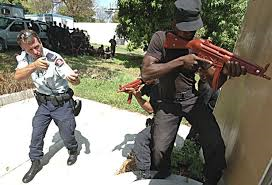 sharp contrast to the CIDA-funded reports produced by NCHR-Haiti, the above statement goes a long way to explain the true motivations behind the illegal incarceration and torment suffered by Haiti’s constitutional Prime Minister during the post-coup period when “Haitian” justice and prison systems effectively fell under Canadian control. While Mr. Neptune was being punished in jail for his refusal to condone the coup, Paul Martin went to Haiti in November 2004. This was the first ever official visit of a Canadian Prime Minister to Haiti. During his visit, Martin, who dubs himself a proud champion of the Responsibility to Protect doctrine, was quoted by Agence France Press as saying that “there are no political prisoners in Haiti.”[29]
sharp contrast to the CIDA-funded reports produced by NCHR-Haiti, the above statement goes a long way to explain the true motivations behind the illegal incarceration and torment suffered by Haiti’s constitutional Prime Minister during the post-coup period when “Haitian” justice and prison systems effectively fell under Canadian control. While Mr. Neptune was being punished in jail for his refusal to condone the coup, Paul Martin went to Haiti in November 2004. This was the first ever official visit of a Canadian Prime Minister to Haiti. During his visit, Martin, who dubs himself a proud champion of the Responsibility to Protect doctrine, was quoted by Agence France Press as saying that “there are no political prisoners in Haiti.”[29]
Haiti’s Prime Minister, Yvon Neptune, was eventually freed under René Préval’s presidency. His release occurred after all risk was effectively cleared that dozens of illegally incarcerated top leaders of Fanmi Lavalas would register and win the foreign controlled elections of 2006.
Months after his return to Canada, Prime Minister Martin was publicly denounced by activist Yves Engler with the infamous heckle “Martin lies, Haitians die” for his shameful behavior in Haiti. During another episode of colourful protest, Engler decorated then Foreign Affairs Minister Pierre Pettigrew’s hands in the red of Haitian blood. For his efforts, Engler ended up spending several days in jail.[30]
What is becoming clearer is the hugely embarrassing contradiction between the multi-million dollar contributions which the Canadian government boasts having made to help fix the Haitian police and justice systems and the fact that said systems are deemed by several independent studies to be in much worse shape several years after the coup. The suggestion that this “failure” is solely that of Haitians also falls flat in the face of scrutiny. Consider the bold statements made by Chief Superintendent David Beer, Director General of International Policing at the RCMP at the April 3, 2008 meeting of The Standing Committee on Foreign Affairs and International Development:
 “Mr. Chair, I think the committee might be interested to know that although our numbers are down to a certain degree in the total number of almost 1,900 serving police officers, in the mission Canada continues to have very key roles. Indeed, Canada holds the position of deputy commissioner of operations, senior mentor and advisor, and senior mentoring unit for the police for the city of Port-au-Prince. We are in charge of the Bureau de la lutte contre le trafic des stupéfiants, the counter-narcotics unit. We’re also in charge of the anti-kidnapping unit. We also contribute to border management, the academy, and la formation de la police nationale. Also, we’re involved in a financial integrity and assets management project within the Haitian National Police. Finally, Mr. Chair, the vetting and registration of the HNP is also a responsibility of a Canadian police officer”. [31]
“Mr. Chair, I think the committee might be interested to know that although our numbers are down to a certain degree in the total number of almost 1,900 serving police officers, in the mission Canada continues to have very key roles. Indeed, Canada holds the position of deputy commissioner of operations, senior mentor and advisor, and senior mentoring unit for the police for the city of Port-au-Prince. We are in charge of the Bureau de la lutte contre le trafic des stupéfiants, the counter-narcotics unit. We’re also in charge of the anti-kidnapping unit. We also contribute to border management, the academy, and la formation de la police nationale. Also, we’re involved in a financial integrity and assets management project within the Haitian National Police. Finally, Mr. Chair, the vetting and registration of the HNP is also a responsibility of a Canadian police officer”. [31]
The conspicuous exchange of funds between CIDA and NCHR-Haiti which financed Mr. Neptune’s ordeal may never make the front pages of Maclean’s Magazine or the Globe and Mail. Generally speaking, Canadians meet with great surprise and disbelief the recurring corruption scandals involving their political elite. One of the cases currently in front of the courts involves former Prime Minister Brian Mulroney who is accused of having accepted bribes in cash, while in office, from German arms dealer Karlheinz Shreiber. Many are shocked by the case. However, that the Mulroney-Shreiber deal in question allegedly involved the purchase of weapons destined to “peacekeeping” has attracted no special attention. If anything, it seems, Brian Mulroney stands to benefit from the “peacekeeping” connection that he volunteered about his dealings with the infamous arms dealer.
Peace Be Unto Them . . . With Tanks and Bullets
In fact, bloody foreign interventions dubbed ‘peacekeeping’ enjoy such a positive aura in Canada that para-governmental bodies such as FOCAL are openly calling for Canada to engage ever deeper in the imperialist adventure that is The Ottawa Initiative.
It is this aura which inspires military figures such as Major Michael D. Ward to write that “strong commitment to the sovereignty [and] independence … of Haiti is a crucial barrier to the international engagement required to rebuild and reform the Haitian state.”[32]
Such crude and condescending statements explain why the North-South Institute cautioned, as early as October 2005, that “The Canadian government’s justification for the 2004 intervention in Haiti, without open debate from an R2P perspective, has damaged the R2P campaign, particularly in Latin America and the Caribbean.”[33] The CIDA-funded think tank proceeds to lament how ‘peacebuilding’ in Haiti has been compromised by de facto collaboration with paramilitary leaders responsible for past human rights violations.
In the very document produced by the R2P Commission, it was boldly highlighted how governments engaged in such interventions must prove themselves to be very agile at spinning and controlling information. “The key to mobilizing international support,” it states, “is to mobilize domestic support, or at least neutralize domestic opposition.” Further, it highlights the crucial role that government-funded entities (wrongly referred to as ‘non-governmental agencies’ – NGOs) have to play in this regard: “NGOs have a crucial and ever increasing role, in turn, in contributing information, arguments and energy to influencing the decision-making process, addressing themselves both directly to policy makers and indirectly to those who, in turn, influence them.”[34]
It thus falls to heavily-funded NGOs to ensure that racism is seen as humanism and imperialism as peacekeeping – no matter the native body count. It is hardly surprising, then, that in the eyes of people of African-descent worldwide, Canada’s “good” image has suffered a considerable blow as a result of the 2004 coup and its aftermath.
Commenting on the food riots that rocked Haiti in April 2008, veteran journalist John Maxwell, wrote in the Jamaica Observer:
“Today, and especially for the last few weeks, the starving people in Haiti have been trying to get the world to listen to their anguish and misery…Mr Bush and Mr Colin Powell and a mixed gaggle of French and Canadian politicians had decided that freedom and independence were too good for the black people of Haiti. Lest you think I am being racist, there is abundant evidence that the conspiracy against Haiti was inspired by racial hatred and prejudice…I have gone into this before and I will not return to it today . . . Suffice it to say that the US, Canada and France, acting on behalf of the so-called ‘civilised world’, decided on the basis of lies that, as in the case of Iraq, a free and independent people had no business being free and independent when their freedom and independence was seen to threaten the economic interest of the richest people in Haiti and, by extension, the wealthiest countries in the world”.[35]
Conclusion
According to Walter Dorn, there exist two groups of advocates of the Responsibility to Protect doctrine. “The idealist or internationalist school often clashes with the realpolitik school, whose members are usually called realists (although not necessarily realistic),” says the military professor. “Canadian realists hold that Canada’s contributions do not arise from the purity of our souls or national benevolence, but because of basic national interest.” Dorn tells us that, for the realists, “Canada’s large contributions to the UN’s successive missions in Haiti are also explained in part by a desire to assist the US in the continental backyard.”
Speaking about his own ‘civilized world’s responsibility to protect ‘others’ in early 2003, then-Minister for la Francophonie Denis Paradis was quoted by journalist Michel Vastel as follows: “I do not want to end up like Roméo Dallaire…” “Time is running out because, it is estimated that Haiti’s population could reach 20 million in 2019,” observed Vastel, before proceeding to quote Minister Paradis describing Haiti’s 99 percent African population as “a time bomb which must be stopped immediately! ”[36]
It is frightening for a historically-conscious person, especially one of African descent, to observe how the logic of Rudyard Kipling’s ‘White man’s burden’ emanates so easily from the minds of high-ranking Canadian officials and intellectuals, and then is translated into foreign policy that is implemented with brute force. As Sherene Razack writes in Black Threats, White Knights, “Peacekeeping today is a kind of war, a race war waged by those who constitute themselves as civilized, modern and democratic against those who are constituted as savage, tribal and immoral.”[37]
A report issued by the International Commission argues that “there is much direct reciprocal benefit to be gained in an interdependent, globalized world where nobody can solve all their own problems: my country’s assistance for you today in solving your neighbourhood refugee and terrorism problem, might reasonably lead you to be more willing to help solve my environmental or drugs problem tomorrow.”[38] One is indeed well advised to ask the crucial question: What are they talking about as far as R2P is concerned? This so-called responsibility is to protect who from what? Are soldiers being mobilized to protect vulnerable populations from massive human rights horrors or to protect the interests of world elites from threats such as Haiti’s perceived black “time bomb”, or Europe from the advances of the wretched of the earth arriving by way of Morroco and Spain?
While seeking the answer to that pivotal question, I am mindful of the shocking statement made by the Assistant Secretary General of the OAS, in front of myself as well as several other witnesses at Haiti’s Hotel Montana, on December 31, 2003: “The real problem with Haiti” said Luigi Enaudi, “is that the ‘International Community’ is so screwed up & divided that they are actually letting Haitians run Haiti.” Less than two months after Einaudi uttered these words, US Marines entered the residence of Haiti’s president, while Canadian RCMP soldiers secured the airport to facilitate the coup and occupation of Haiti. Since that fateful night, Haitians are no longer running Haiti and the bloodbath the foreign invaders claim to have intervened to avoid has reached unprecedented proportions, with full involvement of the UN forces engaged in what can only be defined as class and race warfare. Meanwhile, the world still awaits a serious report on the circumstances surrounding the death of U.N. Commander Urano Teixeira Da Matta Bacellar, at Hotel Montana, on January 7, 2006.
Bill Graham, Former Canadian Foreign Minister in January 2007 interview cited in Janice Gross Stein and Eugene Lang, The Unexpected War: Canada in Kandahar (Toronto, ON: Viking Canada, 2007), pp. 126-27
What Should Canadian Policy Towards Haiti be? – beyond figurehead politics… making a real paradigm shift!
Contrary to the IMF style of “aid”, the Cuba-Venezuela model is, in essence, what activists for peace with justice have been advocating for several years. Unfortunately, successive Canadian governments have chosen to ignore this message and, instead, have multiplied workshops, conferences, meetings (usually, with little or no Haitian participation) to coordinate even more “aid” to Haiti. This is done in blatant disregard of the evidence that Haiti has, for far too long, been “aided to death” by its self-appointed foreign friends.
The appalling poverty found in Haiti is no recent phenomenon due to “bad governance,” as is often posited by apologists for the violent conquest of this continent. The endemic vulnerability of the African and First Nations populations of the Americas stems from 500 years of inhumane colonial and neo-colonial policies. A strategy consisting in piling up money and weapons, while patching up a brick school, a dispensary and a few prisons in return for shameless waving of countless Canadian flags, is no solution at all.
Commenting the current world hunger crisis, Jeffrey Sachs suggested that the long-term solution involves putting brakes on the U.S. ethanol industry, creating a $5-billon fund for agriculture, and financing better research and development for crop technologies in the developing world.[39] Laudable goals, indeed! However, judging from the Haitian experience, governments of enriched societies who built their wealth on racial slavery, theft of indigenous land and shameful trickery of the world financial system, can hardly be counted upon to make such a radical 180 degree conversion. It will necessitate a mass mobilization of peoples worldwide to force these urgently needed changes. Reversing the situation requires us all to force the enriched states to adopt new policies and approaches, rather than rehashing the same old racist practices, masked or not, with clever and cynical humanitarian rhetoric. Their challenge is to first stop doing harm, and then repair the damage already done. Our challenge is to consistently practice genuine people-to-people solidarity.
NOTES
[1] “World Sees Canada as Tolerant, Generous Nation,” Angus Reid Global Monitor : Polls & Research (November 12, 2006).
[2] Walter Dorn, “Canadian Peacekeeping: Proud Tradition, Strong Future?” Canadian Foreign Policy, Vol. 12, No. 2, (Fall 2005)
[3] Canadian International Development Agency (CIDA) website [www.acdi-cida.gc.ca/CIDAWEB/acdicida.nsf/EN/JUD-12912349-NLX]
[4] Michael Petrou, “Haiti: Are we helping?,” Mclean’s (April 7, 2008)
[5] See Marguerite Laurent, “It’s Neither Hope nor Progress when the International Community is Running Haiti,” Haitian Lawyers Leadership Network, [www.margueritelaurent.com] and Aaron Lakoff, “The Politics of Brutality in Haiti: Canada, the UN and “collateral damage,” Dominion Paper (January 21, 2006).
[6] Anthony Fenton and Dru Oja Jay, “Declassifying Canada in Haiti” Global Research [www.globalresearch.ca]; and Canada Haiti Action Network website [www.canadahaitiaction.ca]
[7]Report No. 30882-HT, “Program Document of TheInternational Development Association to the Executive Directors for an Economic Governance Reform Operation”, World Bank, (December 10, 2004)
[8] DeWayne Wickham, “Payoffs to Haiti’s renegade soldiers won’t buy peace,” USA Today (January 3, 2005)
[9] Jean Saint-Vil, “Please Fix Canada’s Policy Towards Haiti,” Letter to Minister Peter McKay, (May 29, 2008) [www. archivex-ht.com]
[10] Jean Saint-Vil. “New Canadian Premier Gets Sound Advice on Haiti,” Letter to Prime Minister Stephen Harper, (February 6, 2006) [www. windowsonhaiti.com]
[11] Five LDCs — Haiti, Cape Verde, Samoa, Gambia and Somalia — have lost more than half their university-educated professionals in recent years because these professionals have moved to industrialized countries in search of better working and living conditions. UNCTAD, “Least Developed Countries Report 2007: Knowledge, Technological Learning and Innovation for Development” [www.unctad.org] (July 19, 2007)
[12] President René Préval’s Inaugural Speech, Haiti, (May 14, 2006) [www.margueritelaurent.com]
[13] The New York Times appears to have been better connected to the real powers running the show in Haiti. Because of its precipitous attribution of the price reduction measure to Mr. Préval, the Times issued a correction note dated April 10, 2008, in which one reads “A picture caption last Thursday about rioting in Haiti over high food prices misstated President Rene Préval’s position on the issue. He urged Haitians to become agriculturally self-sufficient; he did not say he would urge Haiti’s congress to cut taxes on imported food.” See “Haiti’s President Tries to Halt Crisis Over Food,” New York Times (April 10, 2008).
[14] Cited in Robert Muggah, “Securing Haiti’s Transition,” Small Arms Survey Occasional Paper no. 14 (October 2005)
[15] In interview with Haitian President René Préval, March 2006, Ottawa.
[16] “An Inside Look at Haiti’s Business Elite, An Interview with Patrick James,” Multinational Monitor (January/February 1995)
[17] HAITI: Fanmi Lavalas Banned, Voter Apprehension Widespread, By Jeb Sprague, IPS (april 17, 2009)
[18] Jean Saint-Vil, “Haiti’s ‘Ambassador’ to Canada” Znet (June 9, 2005) [www.zmag.com]
[19] Reed Lindsay, “Haiti’s future glitters with gold,” Toronto Star (July 21, 2007)
[20] Maj. J.M. Saint-Yves, “Defining Canada’s Role in Haiti”, (Toronto: Canadian Forces College Master of Defence Studies Research Project, 2006), [http://wps.cfc.forces.gc.ca]
[21] Marguerite Laurent, “Debt Breeds Dependency Equals Foreign & Corporate Domination” [www.margueritelaurent.com], (January 4, 2005)
[22] Hansard,House of Commons, 37th Parliament, 3rd Session (March 10, 2004)
[23] Hansard, Debates of the Senate, 2nd Session, 37th Parliament,
 (March 19, 2003)
[24] “Using NGOs to Destroy Democracy and the Canadian Military Connection,” excerpt from: Canada in Haiti Waging War on the Poor Majority by Yves Engler and Anthony Fenton. Fernwood Publishing, 2005
[25] Peter Hallward, “Damming the Flood: Haiti, Aristide and the Politics of Containment”, Verso Books, 2007
[26] Kevin Skerrett, “Faking Genocide: Canada’s Role in the Persecution of Yvon Neptune,” Znet (June 23, 2005) [www.zmag.org]
[27] Tom Reeves, “Haiti’s Disappeared,” Znet [www.Zmag.org] (May 5, 2004)
[28] Kevin Pina and Andrea Nicastro, “Interview with Prime Minister Yvon Neptune,” Haiti Action (March 2, 2004) [www.haitiaction.net]
[29] “Canada in Haiti for long run, says PM,” Caribbean Net News (November 19, 2004)
[30] Marcella Adey and Jean Saint-Vil, “Human Rights worker arrested for heckling Prime Minister Paul Martin” globalresearch.ca (December 4, 2005)
[31] Hansard, 39th Parliament, 2nd Session, Number 021 “Evidence” Standing Committee on Foreign Affairs and International Development, (April 3, 2008)
[32] Major Michael T. Ward, “The Case for International Trusteeship in Haiti” Canadian Forces Journal, vol. 7, no. 3 (Autumn 2006)
[33] Stephen Baranyi, “What kind of peace is possible in the post-9/11 era?” North-South Institute , (October 2005)
[34] ICISS (IBID)
[35] John Maxwell, “Is Starvation Contagious?” Jamaica Observer (April 13, 2008)
[36] Michel Vastel, “Haiti mise en tutelle par l’ONU?” L’Actualité, (March 15, 2003)
[37] Sherene H. Razack, “Black Threats & White Knights: The Somalia Affair, Peacekeeing, and the New Imperialism”, University of Toronto Press, (2004)
[38] ICISS, “Report of the International Commission on Intervention and State Sovereignty” (page 71), [www.iciss.ca] (December 2001)
[39] Sinclair Stewart, “Facing a food crisis, optimist finds hope in the dismal science,” The Globe and Mail (Wednesday April 30, 2008)


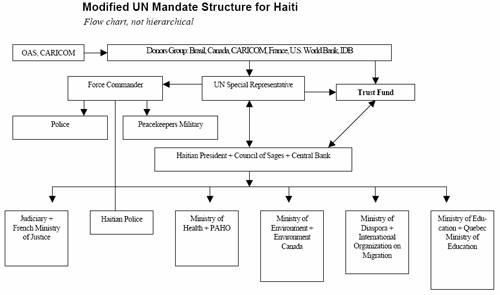
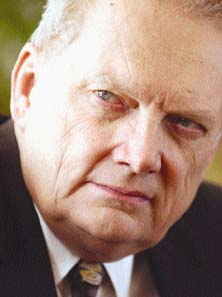
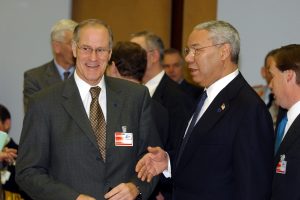
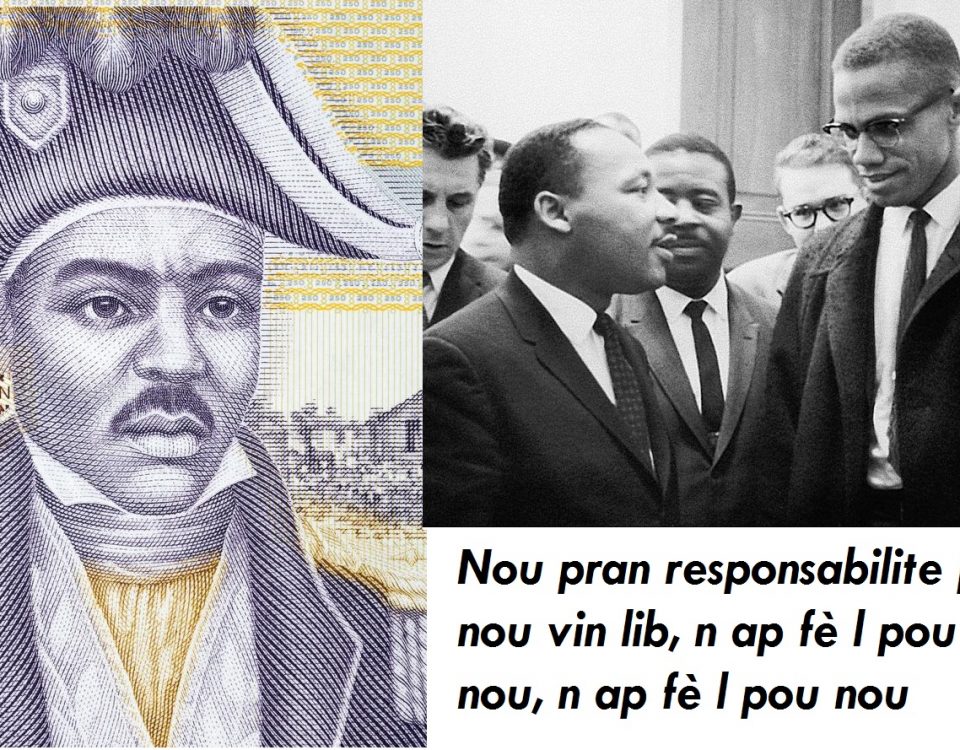


1 Comment
Excellence piece of Journalism! We need at every occasion and at every turn to show the duplicity, the hypocrisy oft hose who claim to help but used nefarious schemes and tactics to keep Haiti in this dire situation. Say it again! These barbaric crusaders as well as the happy cretins are the same ones that continuously used the media and Websites that have comment sections that provide the opportunity for the ruling elites to hire the slander of truth-tellers. This is seen wherever the elites playbook is exposed. Again, excellent work!